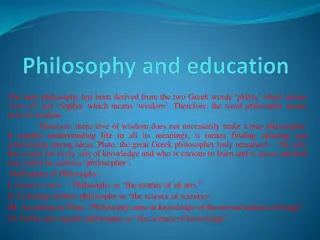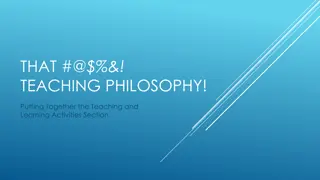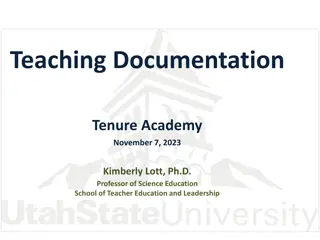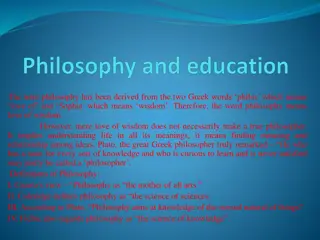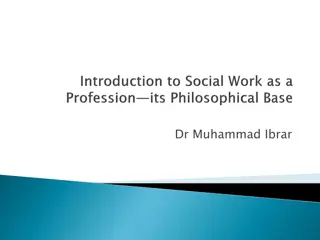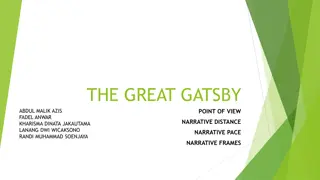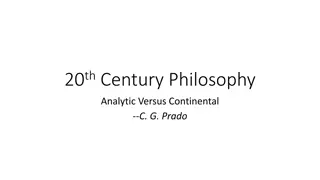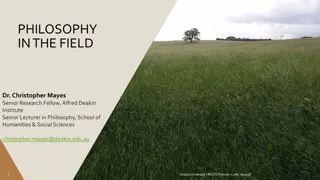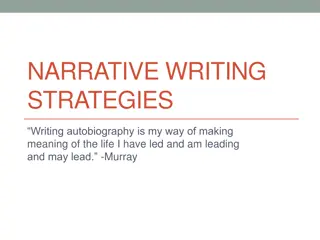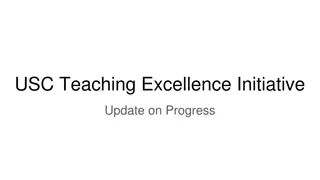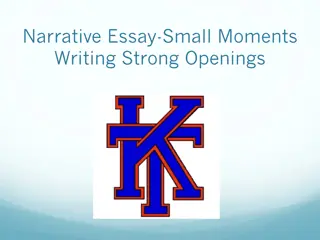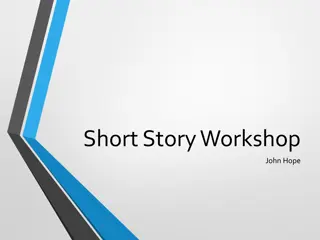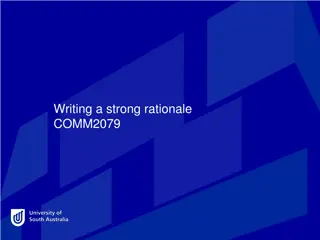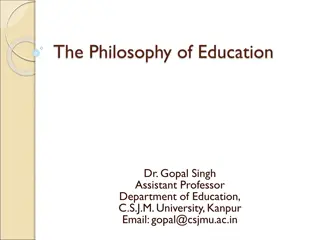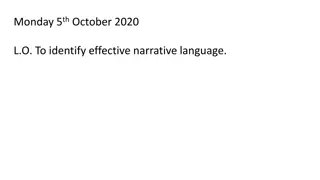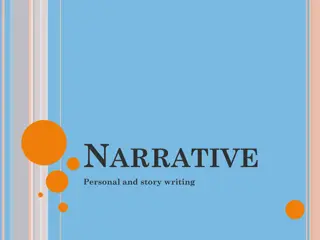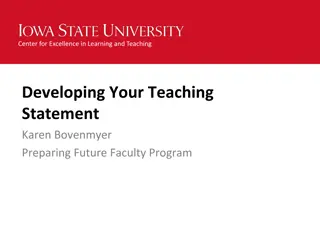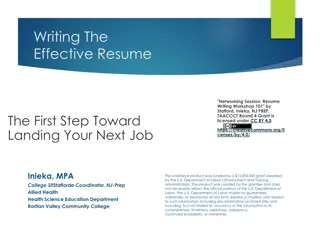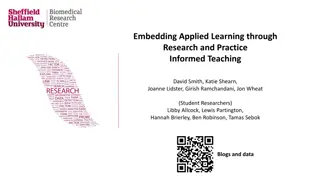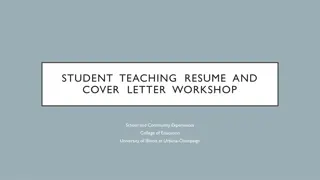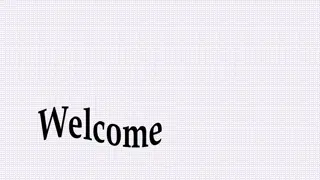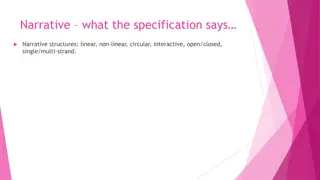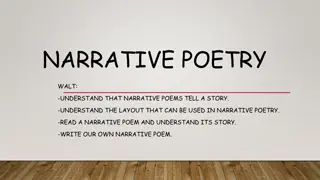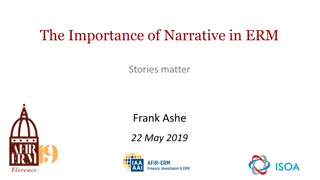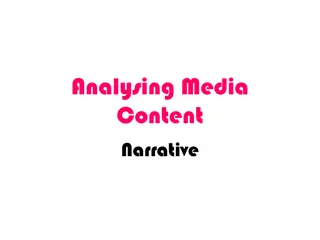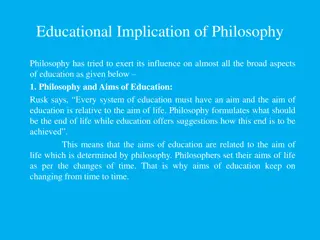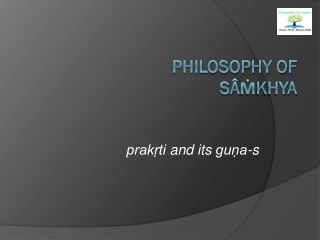Crafting a Strong Teaching Philosophy & Research Narrative Workshop
This workshop explores the key areas and structure of a statement of teaching philosophy, aiming to enhance participants' ability to evaluate and improve their teaching and research philosophies. Participants will reflect on personal beliefs, values, and strategies to create an effective teaching philosophy. The session emphasizes the importance of a clear narrative that reflects the essence of teaching and learning.
Download Presentation

Please find below an Image/Link to download the presentation.
The content on the website is provided AS IS for your information and personal use only. It may not be sold, licensed, or shared on other websites without obtaining consent from the author. Download presentation by click this link. If you encounter any issues during the download, it is possible that the publisher has removed the file from their server.
E N D
Presentation Transcript
Creating a Strong Teaching Philosophy and Research Narrative Javier Cavazos Vela and Claudia Vela Center for Teaching Excellence (CTE)
Learning Objectives After this interactive workshop, you will be able to: Recognize potential key areas of a statement of teaching philosophy Identify potential structure for a statement of teaching philosophy Evaluate a statement of teaching philosophy Create a plan to improve your teaching and research philosophies
Focus Activity Take 5-minutes to reflect and respond to questions on the following handout, Statement of Teaching Philosophy: Potential Important Areas to Consider When you are done, turn to your neighbor and take 4-minutes to share your responses.
What is a Statement of Teaching Philosophy? A statement of teaching philosophy is a clear and concise narrative that answers the following direct question: What does teaching and learning mean to you? Hegarty (2005) stated that a statement of teaching philosophy is the mission statement of a faculty member which declares where they would like their teaching to go and in doing so helps to keep faculty motivated and committed to constant improvement.
Potential Key Areas Ideas or theories toward teaching and learning Personal views toward teaching Teaching strategies Learning environment Student learning objectives Assessment activities Professional development activities
Teaching Philosophy Structure Between one and two pages long; single-spaced; and 11 or 12-point font A personal narrative Evidence of personal beliefs and values Representative of experience and practice Showcase for strengths Place that points to directions toward future growth Effective abstract for a teaching portfolio
Focus Activity The purpose of this activity is to evaluate a statement of teaching philosophy. Evaluate your neighbor s statement of teaching philosophy using our rubric. Take 8-minutes to evaluate and make sure to provide feedback to make improvements
Reflection What areas of your partner s statement of teaching philosophy are strong? What areas could use improvement? What needs to be done to improve these areas? What do you think about the potential areas to include in a statement of teaching philosophy? Are there some that you would not include or others that you would include?
Research Narrative What is the impact, quality, intentionality, and significance of your scholarship?
Research Narrative Impact Grant funding, citation metrics, journal acceptance ratings, impact factors, collaboration with students and colleagues Intentionality Research focus Connections among research, teaching, and service Write and collaborate with intent Submission to specific peer-reviewed journals or funding agencies
Research Narrative Significance Fill gaps in the literature Implications that influence practice or policy Provide students with research experiences Grant funding
Final Remarks Thank you for participating in this interactive workshop where we hope you met session objectives and developed a plan to improve your teaching or research philosophies. Please complete evaluation questions about your learning experiences and level of satisfaction. Please also take a look at resources on our website utrgv.edu/cte which will provide helpful and additional information.
References and Helpful Resources Axelrod, R. B., & Cooper, C. R. (1993). Reading critically, writing well: A reader and guide (3rd ed.). New York, NY: St. Martin s. Chism, N. V. (1998). Developing a philosophy of teaching statement. Essays on Teaching Excellence, 9, 1-2. Professional and Organizational Development Network in Higher Education. Coppola, B. P. (2002). Writing a statement of teaching philosophy: Fashioning a framework for your classroom. Journal of College Science Teaching, 31, 448. Goodyear, G. E., & Allchin, D. (1998). Statement of teaching philosophy. In M. Kaplan (Ed.), To improve the academy (pp. 103-122). Stillwater, OK: New Forums Press. Hegarty, N. (2015). The growing importance of teaching philosophy statements and what they mean for the future: Why teaching philosophy statements will affect you. Journal of Adult Education, 44, 28.
References and Helpful Resources Kaplan, M., O Neal, C., Meizlish, D., Carillo, R. & Kardia, D. (n.d.). Rubric for Statements of Teaching Philosophy. Kearns, K. D. and Sullivan, C. S. (2011). Resources and practices to help graduate students and postdoctoral fellows write statements of teaching philosophy. Advances in Physiology Education, 35, 136-145. Landrum, R. E., & Clump, M. A. (2004). Departmental search committees and the evaluation of faculty applicants. Teaching of Psychology, 31, 12-17. Sch nwetter, D. J., Sokal, L., Friesen, M., & Taylor, K.L. (2002). Teaching philosophies reconsidered: A conceptual model for the development and evaluation of teaching philosophy statements. International Journal of Academic Development, 7, 83-97. The University of Texas at Austin Faculty Innovation Center (2017). Teaching statement. Retrieved from https://facultyinnovate.utexas.edu/opportunities/prof-dev/statement Weimer, M. (2011). Writing better teaching philosophy statements. The Teaching Professor, 25, 6.


